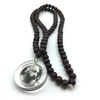The Long Reach of the Dharma
Bhagawati reviews Deva Abhiyana’s newly released book.
It’s a pleasure to introduce you to this exhilarating and encompassing story of an inimitable life that begins with a small boy growing up in a middle-class Jewish family in San Francisco. I think it is the first autobiography ever written by a sannyasin of Jewish background – yet there is none of the traditional bred-in kvetching, barely any guilt peeking from behind a corner but instead lots of humor – in spite of the arduous and long time it takes for the relationship with his father to be resolved.
I’ve known Abhiyana since the seventies, or so I thought. What I did not know, which became apparent by reading the book, were his adventures, his daring spontaneous moves into the unknown, his at times furiously erupting anger, and freak-outs to boot. He bares his innermost core, no holds barred, and carries on with an undiminished quest for life – an old soul whose incarnation is punctured by insights that trigger his subconscious memory into understanding why he is here.
From a young age, he was touched by Zen stories, later explored the novel new age therapies and developed a huge interest in the paranormal. One of his peak insights was the recognition that acupuncture and Chinese medicine are his vehicle to serve humanity and which finally took him to study in London; at the same time, he also learned Mandarin. After taking a liking to Zazen, he dropped that in favor of moving into the Sufi world where he met Pir Vilayat Inayat Khan during a month-long meditation camp in France. Pir Vilayat initiated him, telling him about another master he would soon meet and initiate him fully.
In the summer of 1976, having graduated successfully, he sets out on the ‘hippie trail’ – general direction India. The descriptions of his travel adventures, the meetings with ‘remarkable men’, getting to know the customs of exotic societies and other religions, make exciting and inspiring reading. In Turkey, totally unexpected, he is given the name Yusuf by Sufi mystic Suleyman Dede who tells Abhiyana he had been waiting for him. And all along throughout his travels, often experiencing harrowing incidents, he is invisibly supported by the unseen, the Dharma. And I could hear his sigh when he describes entering India, feeling he is home at last. Yet another twist of the Dharma propels him first to Tibet, before the tracks point straight to Pune, to Osho.
Yusuf becomes Deva Abhiyana in January 1977 and the years of surrendering to the Master and commune life unfold. Cheerful memories of Pune, of ashram lore and his experiences as an acupuncturist are topped by well-selected excerpts from Osho’s discourses that underline the ups and downs of his inner journey, the latter often due to relationship adventures and woes that continue for years to come!
In 1981, curious circumstances get him to ‘the Castle’ in New Jersey before Osho arrives there; from there, via Utsava, he finally reaches the Ranch where communal life presents itself radically different; Abhiyana’s depictions of life in Rajneeshpuram are riveting and diverse, and many memories came rushing back. Abhiyana says it took him thirty years to understand the lessons of Rajneeshpuram and he did a lot of soul-searching before writing the chapters following the years we lived there, trying to come to grips with what really happened. The fundamental job he did with that is extremely helpful for a deeper understanding of the events of that time.
Establishing himself after leaving Rajneeshpuram in Marin County as an acupuncturist and practicing Chinese Medicine, the Dharma reached out another time and by the beginning of 1987 he arrived again in Pune, Osho just having moved from Mumbai to the ashram. Immersed in yet another phase of communal life, he witnesses the Master’s work coming to a crescendo: “Osho went the extra mile like no master before him, to help awaken us to reality.” Among the many recollections of sometimes even bizarre events, is also an extremely touching episode about Abhiyana giving Osho an acupuncture session.
After Osho left his body, he stayed for several years in the Pune commune, before joining the Osho Academy in Sedona, established by Kaveesha who became his teacher. He later also married and made a conscious decision to have a child which was born in 2006, presaging a new journey into unchartered waters that the Dharma has nudged him to set sail for.
Abhiyana’s skillful storytelling – honed in many caravanserais down the ages I dare say – made me feel like a participant rather than an onlooker, often laughing, sometimes with tears in my eyes. Very much appreciated are the many photographs illustrating people and events, as well as the many stirring quotes throughout. Highly recommended reading!
Review by Bhagawati
Thanks to Osho Viha who suggested we review this book; a shorter version will be published in Viha Connection November/December 2017
Related excerpt
The Castle
Available at Osho Viha – amazon.com – amazon.co.uk – amazon.de – amazon.in
American-born Abhiyana came to Pune in 1976 and lived for years in Osho’s communes in India and the USA. A Doctor of Oriental Medicine, he is author of ‘Osho Divine Healing: A SpiritMindBody Workbook’. Together with his partner Madhu and daughter Sharadevi, he now lives and practices acupuncture in Sedona, Arizona. Sedona-Acupuncture.com
- Log in to post comments
- 12 views
